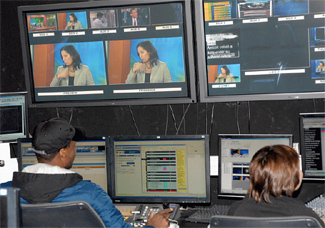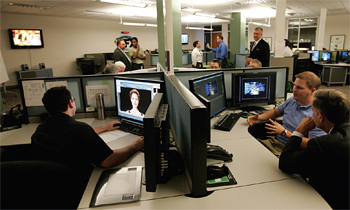21st Century News Graphics

NY1, Time Warner’s New York City news channel, uses Chyron’s MicroX graphics system.
TORONTO
The days of standalone character generators and graphics stations are over. In today's TV stations, titles and graphics are just a key's click away for producers working on nonlinear editing systems.
This degree of integration has resulted in basic news graphics by produced by journalists as they cut their stories electronically; eliminating the position of dedicated CG operators at many TV stations. But the benefits of speed and economy that graphic integration provides today is not the end of the story: More advances are on the horizon.
THE NEW NEWSFLOW
The advent of the MOS (Media Object Server) XML protocol more than a decade ago made it possible for computer-rendered graphics to be accessed by newsroom automation systems such as ENPS.
MOS' capabilities have made a believer of Gerry Belec, director of technology and design for Canada's Global TV. "Our Digital News project at Global [TV Canada] is tightly integrated with ENPS and the MOS protocol," he said. "We've made it clear to any broadcast vendor looking to partner with us that any future device that gets integrated into our production workflow must adhere to this protocol."
For reporters working on ENPS and other such systems, MOS-based templates allow them to input basic information into commonly used screens, such as names and titles of people being interviewed on camera. "In creating a template-based graphics system, we were able to delegate the daily 'bread and butter' graphics either to automatic systems, or for populating by the journalist on a newsroom systems," said Petter Ole Jakobsen, CTO of Vizrt, based in Bergen, Norway. "This freed the graphics department to work on creating event and breaking news graphics; plus graphics for more complex stories."
Meanwhile, CG operators who only typed in mundane data—such as names, titles, and sports scores—were no longer required. This saved broadcasters some payroll dollars, while allowing them to do more in their existing facilities. "We have a small control room," said Barry Stubbs, chief engineer of WGMT-TV in Macon, Ga. WGMT uses Pixel Power's Clarity graphics platform. "Not having to make room for a CG operator let us add new technology while staying with a four-person news control room crew."
ADVANCES AND PLANS
MOS-based interfaces are now offered by most major graphics vendors including Avid, Chyron, Compix Media, Harris, Miranda Technologies, Orad, Pixel Power and Vizrt. Moreover, these companies are looking for ways to push the envelope of TV graphics even further.
For instance, Harris' Inscriber graphics software allows template designers to create complex templates using RTX scripting. "With RTX scripting, a reporter can automatically change graphic elements, typefaces, or colors based on the tag data entered into the graphic template," said Curtis Mutter, product line manager for Harris' Inscriber Graphics Systems. "So rather than having to scroll through a long list of totally formatted templates, a few master templates that incorporate RTX scripting can be used, and based on the tag data entered by the reporter, the graphic will automatically format itself to fit the content."
NY1, Time Warner's New York City news channel, uses Chyron's MicroX graphics system (with Chryon's Camio at its core) on its Dalet Enterprise Edition news production system. "With the Chyron system, we are able to use the same templates for different shows by 're-skinning' them," said Joe Truncale, vice president of engineering and operations for NY1. "With re-skinning, you can have the reporter enter information into one template, then have the system automatically reformat the look of the templates graphics, colors and typefaces to serve multiple shows. In our case, we can re-skin a single template to serve four different programs; saving time and effort while enhancing our on-air look."
Compix Media's graphics products allow for easier template selection by serving up thumbnails of each screen. As well, "Our WYSIWWG [what you see is what you get] approach lets you see a VGA version of the completed template fast," said Lan Merrill, Compix Media's vice president of engineering. "You can make sure everything is right, without having to render the graphic in full resolution."
For Richmond, Va.-based station group Media General, consolidation is the name of the budget-driven game. In order to save money while creating a consistent on-air look, the company has centralized its graphics production into a single MGFX production unit. "We serve 18 Media General stations; 16 of which do news every day," said MGFX GM Jim Doyle. Using Miranda Technology's Vertigo Xmedia graphics suite in concert with the ENPS news production system, MGFX creates the templates and serves them out to its client stations. "The result is quality corporately-branded graphics across our stations, created by a single creative team—and fewer CG operators."

Media General has centralized its graphics production into a single MGFX production unit. "Centralizing graphics creation has several benefits," said Boromy Ung, product manager, workflow & playout for Miranda Technologies in Montreal. These include reduced costs, better on-air appearances for smaller market stations, and faster time-to-air. Ung added that having all of the graphic artists working together "fosters a creative environment that leads to higher productivity."
Avid's Deko graphics platform is designed to create "intelligent templates" that automatically adjust for 16:9 or 4:3, and can be adapted for Web and mobile phones/PDAs as well. "The advantage of this is that one input can serve multiple platforms," said Jim Frantzreb, senior marketing manager for broadcast at Avid Technology in Tewksbury, Mass. "This helps the newsroom cope with feeding content to broadcast, the Web and mobile all at the same time."
Shaun Dail, vice president of sales and marketing for Orad in North America, said that the company is working on a process that will allow changes made to live on-air templates to be made immediately to alternative media such as the Web and mobile and will unveil it at the NAB Show "This will help shorten the news workflow, by removing the need to make such changes manually," he said.
Pixel Power's goal is to integrate real-time 3D graphics into newsroom production systems, according to Pete Challinger, CEO for the Burbank, Calif.-based graphics company. "And we are not just talking over-the-shoulder; increasingly we are including graphics for on set monitors as well," he said. "There is no reason that live video from the on-air studio or remote feeds cannot be digitally mapped onto animated graphics objects to provide more visual impact for all facets of news graphics."
"We also need to include studio videowalls and interactive touchscreens into the news production system," said Vizrt's Jakobsen. "We also need to ensure that our Trio and Pilot graphics systems can work with the Web just as well, and bring interactive graphics both to Web and on-air presentations."
The professional video industry's #1 source for news, trends and product and tech information. Sign up below.
James Careless is an award-winning journalist who has written for TV Technology since the 1990s. He has covered HDTV from the days of the six competing HDTV formats that led to the 1993 Grand Alliance, and onwards through ATSC 3.0 and OTT. He also writes for Radio World, along with other publications in aerospace, defense, public safety, streaming media, plus the amusement park industry for something different.

